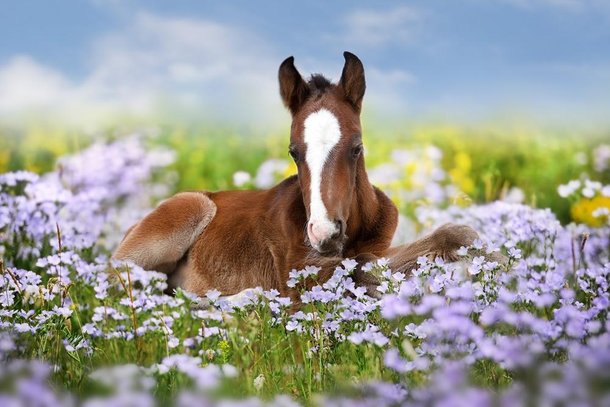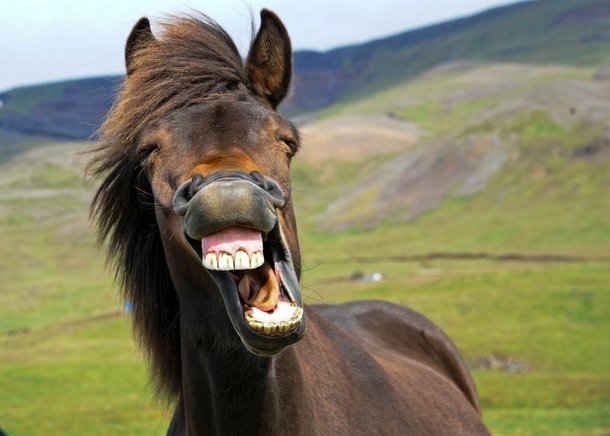Dizem que o cachorro é o melhor amigo do homem. Mas, historicamente, este posto pode ficar com outro animal: o cavalo. Afinal, ele nos ajudou a transportar alimentos, caçar, plantar, esteve ao nosso lado em guerras. Além disso, também pode auxiliar em tratamentos de pessoas com tipos específicos de transtornos e até problemas físicos.
De fato, são animais incríveis. Conheça algumas curiosidades sobre os cavalos e aprenda mais sobre eles!
1. Cavalos são incapazes de vomitar
 (Fonte: Shutterstock)
(Fonte: Shutterstock)
Tal como os humanos, a maioria dos animais vertebrados consegue vomitar. Mas os cavalos perderam essa capacidade com o tempo. O motivo é um anel muscular extremamente forte chamado esfíncter cardíaco situado na entrada do estômago do animal. Essa estrutura é a responsável por impedir que qualquer coisa que entre em sua barriga possa sair.
Em linhas gerais, a única forma de a comida escapar do estômago do animal é se ele sofrer uma ruptura estomacal. Algo que, geralmente, causaria a sua morte. Aliás, como eles não conseguem expelir toxinas ingeridas por meio do vômito, é preciso ter muito cuidado com a alimentação deles.
2. Existem centenas de raças de cavalos
 (Fonte: Shutterstock)
(Fonte: Shutterstock)
Os cavalos foram criados de forma seletiva ao longo de muitos séculos, e isso deu origem as mais de 600 raças de cavalos que se encontram espalhadas pelo mundo atualmente.
Um estudo genético de 2017, conseguiu identificar que todas as raças de cavalos conhecidas hoje descendem de duas raças antigas: os cavalos turcomanos e os árabes. Estes últimos existem até hoje, mas o turcomano, parecido em termos de aparência ao Akhal-Teke, está extinto.
3. Os cavalos dormem em pé
 (Fonte: Shutterstock)
(Fonte: Shutterstock)
Tudo bem, os cavalos dormem deitados, mas você sabia que eles também conseguem dormir em pé? Para que eles tenham um ciclo completo de sono reparador, junto às 7 horas de sono “normal”, precisam ar, no mínimo, 30 minutos diários dormindo em pé para evitar a privação.
Além disso, existem vários fatores que podem influenciar a maneira do cavalo dormir e descansar. Eles podem envolver o espaço disponível, o ambiente, clima, questões físicas e até impedimentos musculoesqueléticos, como a osteoartrite.
4. É possível estimar a idade de um cavalo pelos seus dentes
 (Fonte:Shutterstock)
(Fonte:Shutterstock)
Claro, não é possível dizer a idade exata, mas os dentes dos cavalos podem ajudar nas estimativas sobre sua idade. Aliás, vale ressaltar que esses equinos precisam de cuidados regulares e adequados quanto a dentição.
Além disso, muitas vezes, um cavalo pode viver mais que seus dentes, por isso, na hora de alimentar cavalos idosos, é preciso ter um cuidado adicional com a composição do alimento.
5. Boa parte dos cavalos árabes tem um osso a menos
 (Fonte:Shutterstock)
(Fonte:Shutterstock)
Como apontamos anteriormente, o cavalo árabe serviu de base para uma série de outras raças de cavalos mais leves. Esses animais também possuem características únicas e curiosas. Por exemplo, você sabia que a maioria dos cavalos dessa raça tem uma vértebra (osso da calda ou da costela) a menos que outras raças?
6. Os cavalos foram domesticados a cerca de 6 mil anos

Em termos de domesticação, os cães ganham da maioria dos animais. Afinal, foram domesticados pelos homens há cerca de 14 mil anos. Com os gatos, isso aconteceu por volta de 8.500 anos atrás.
Já a nossa relação com os cavalos é um pouco mais recente, datando algo em torno dos 6 mil anos atrás. No entanto, algumas pesquisas sugerem que esses animais foram domesticados ainda mais cedo.
Fonte: MegaCurioso.